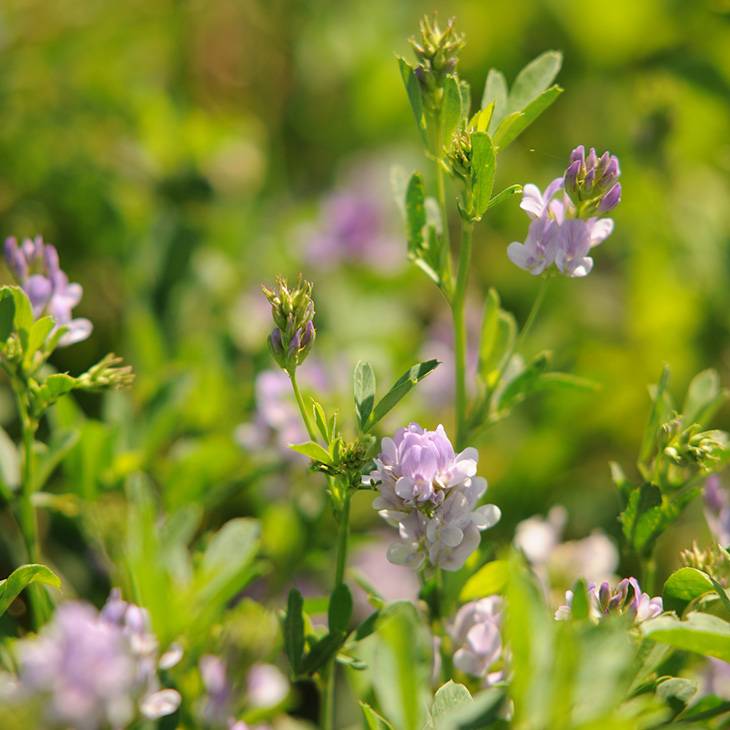Oklahoma State University recommendations maximize alfalfa field productivity
Thursday, July 30, 2020
Producers who will be planting alfalfa in late August and early September can maximize their investment by following research-based recommendations, Oklahoma State University experts said.
Alfalfa has been called the royalty of forage crops as far back as 1909, when an Oklahoma Agricultural Experiment Station bulletin heralded its benefits relative to raising livestock, both for grazing and as hay. Today, cattle grazing alfalfa pastures is a common sight and alfalfa hay generates $107.6 million annually to the Oklahoma economy, according to USDA National Agricultural Statistics Service data.
“Stand productivity and longevity are best on deep, fertile, well-drained loamy or sandy loam soils,” said Alex Rocateli, OSU Extension forage systems specialist. “Soil with good water-holding capacity is important because high alfalfa yields require large quantities of water.”
Alfalfa needs six to eight weeks to germinate and grow before the first freeze. Extensive research has been performed on alfalfa establishment and management and is available online and through all OSU Extension county offices.

Important considerations to remember when establishing alfalfa include:
- If the water table rises to the surface during warm seasons, alfalfa grows poorly and may even die within a few days from flood damage and harmful temperatures, a situation commonly called scald.
- Several adapted alfalfa varieties are available with root rot resistance. They perform better in wet soils than susceptible varieties but cannot tolerate extended periods of standing water.
- Avoid planting alfalfa right after terminating an old alfalfa stand. Old stands produce toxins that inhibit new alfalfa seedling growth. Referred to as autotoxicity or self-toxicity, this can affect new stands from six months to two years.
- Alfalfa takes up a lot of phosphorus and potassium from soils. Every 5 tons of produced forage removes 75 pounds of phosphorus and 300 pounds of potassium.
- Seedbed preparation begins with the removal of the previous crop and involves many possible combinations of farming equipment. Generally, the normal steps include a primary tillage, disking, leveling and smoothing.
“OSU research indicates deep disking can be used as a substitute for moldboard or chisel plowing,” Rocateli said. “In soils that develop hardpans, a chisel plow is commonly used to rip through existing hardpan layers. Disking breaks up the clods and is a good tool for incorporating residue, lime and fertilizer.”
Rocateli provided additional tips for alfalfa establishment in a video segment produced through OSU Extension’s agricultural television show SUNUP, available for viewing online.
The selection of an alfalfa variety is widely considered one of the few irreversible management decisions. That choice has a significant effect on hay yields, degree of insect and disease resistance and stand longevity, all of which affect profits. However, once the seeds are sown, the variety cannot be improved.
Weed control should begin with site selection. A good site is not severely infested with weeds, even in the fence rows. Annual weeds should not be allowed to produce seed in crops preceding alfalfa. A postemergence herbicide is a good option for fall-sown alfalfa.
“Most weeds in fall-sown alfalfa emerge at the same time as the crop in late September,” said Brian Pugh, OSU Extension area agronomy specialist for eastern Oklahoma. “They remain small and inconspicuous until late winter or spring. Postemergence control is most effective when applied to actively growing plants in October or November.”
Alfalfa County Extension Director Tommy Puffinbarger recently spoke about the need to get a soil test before planting alfalfa on the Extension Experience podcast, which provides weekly insights into western Oklahoma’s agricultural activities.
“Given how a well-managed alfalfa field may be productive for up to 10 years, it’s important to get liming levels right to correctly adjust soil acidity,” he said. “I recommend using the grid sampling method of soil testing as it provides a more precise reading of a field’s profile.”
Puffinbarger, Pugh and Rocateli recommended soil have a pH above 6.0 for an ongoing site and above 6.5 for a beginning stand. If a producer has acidic soil and cannot afford to lime, it is probably not a profitable enterprise to plant alfalfa.
MEDIA CONTACT: Donald Stotts | Agricultural Communications Services | 405-744-4079 | donald.stotts@okstate.edu
